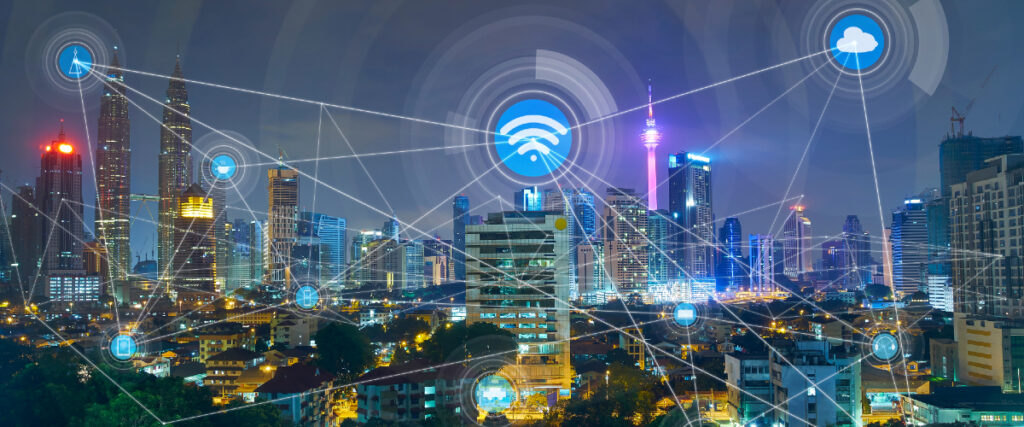The Internet of Things, or IoT, is often associated with things like smart thermostats or other networked devices in the average household. While there are numerous applications for this technology that can make life easier, convenience isn’t the only place where IoT can shine. Let’s take a closer look at six ways the Internet of Things is changing the world for the better.
1. Smart Traffic Lights Reduce Traffic Jams
There’s nothing more annoying than getting stuck in a traffic jam, save perhaps being the last person to reach the line before the light turns red. Traditionally, traffic lights have relied on car counting and carefully constructed algorithms to determine when to change the traffic lights. At the time, this was effective at keeping traffic moving, but the number of cars on the road has increased, and it can’t keep up.
Smart traffic lights, using cameras installed in the lights themselves, can determine when to change the traffic light patterns to reduce congestion. The traffic light patterns will change throughout the day as traffic comes and goes, but it doesn’t require human intervention or a maintenance call.
2. Introducing the Internet of Law
IoT devices, regardless of their applications, collect a massive amount of data. We’ve already seen a shift toward using things like emails and text messages as evidence in litigation. In future cases, the information collected by these connected devices could potentially also be subpoenaed for use in a case.
This is the introduction of the Internet of Law, a subset of the Internet of Things that will apply directly to legal proceedings. This data is currently still protected, but cell phone and email records can be subpoenaed if necessary to use as evidence in a court case. This particular application for IoT devices is still very new, but as more items become connected, it’s likely we’ll see more examples of this technology in the future.
3. Predictive Maintenance Across Industries
Most maintenance schedules right now are designed to catch problems before they cause a piece of equipment to fail, but what if you could predict precisely when something needed to go offline for maintenance?
By using data collected by IoT sensors attached to the machinery, predictive analytics can find patterns. With enough data collected from past events, these systems can even begin to predict ones that could occur in the future.
This isn’t fortune telling, but predictive analytics could help create maintenance schedules so accurate that more traditional schedules are no longer necessary. In turn, this helps streamline the maintenance departments of many industries, reducing unnecessary downtime and even improving safety by keeping each piece of equipment from ever reaching the point of catastrophic failure that could cause harm.
4. Increasing Patient Throughput in Hospitals
Patient throughput is defined as “the movement of patients from arrival to discharge.” In an ideal situation, constant communication between professionals — and a comprehensive data trail — will help ensure the optimal outcome for each patient. Unfortunately, it doesn’t always work that way, and breakdowns in communication can cause a variety of problems.
Like the smart traffic lights mentioned above, IoT sensors paired with a machine learning or analytics system can help optimize information flow to make it easier for professionals to make efficient and informed decisions that optimize patient care and improve throughput in hospitals.
5. Making Remote Work More Seamless
The pandemic made remote work more common than it had ever been before as companies scrambled to keep their teams working while keeping everyone safe. But this has created its own set of challenges as people started logging in to work servers from home and IT departments had to manage all their support calls remotely. People had to find their own equipment or have laptops issued by their employers, and monitoring and maintaining these devices became more difficult.
IoT sensors are a valuable tool for IT professionals, allowing them to remotely monitor the state of equipment without having to assess each piece in person. These sensors can monitor everything from the temperature of the machines to their condition or details of their use. For companies issuing work laptops to their employees while they work from home, the information these sensors collect can be invaluable.
6. Supporting Self-Driving Cars
While current incarnations of self-driving cars are limited to the level 2 autonomy that Tesla has achieved — requiring the driver to be ready to take over at any time should the need arise — the technology is swiftly evolving. It won’t be long before self-driving cars become the norm. One unique feature of self-driving cars is their ability to use the IoT to “talk” to one another.
One self-driving car has the ability to convey collected data about anything from weather and road conditions to traffic patterns and any other pertinent information about the roads they’ve traveled. The receiving vehicle can then use the collected data to change its expected route. In theory, this sort of communication network could be used to reduce or even eliminate traffic congestion if there are enough of these self-driving cars on the road.
Looking Toward the Future
The massive series of networked devices known as the Internet of Things may still be picking up momentum, but it is evolving as we watch. This sort of technology has the potential to change the world, and it’s already started with the examples listed above. Who knows what the next five or 10 years might bring as we watch IoT devices begin to reshape the way we live?
